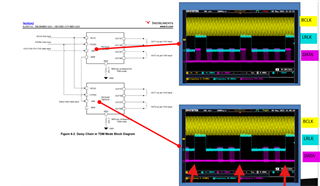Tool/software:
Hi TI,
I am using TAD5242 to input TDM signals at DIN (channel = 4, Left Justified, MSB First, One Subframe, Word Width = 32, Bit Depth = 24, Falling Edge Sync, FS = 48kHz),
and observing MD6 with an oscilloscope.
I noticed an unusual signal and would like to understand what it is. Could it cause pop noise or other abnormal behavior?



